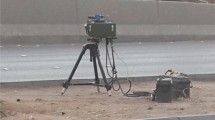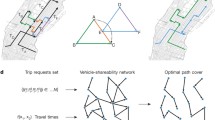Abstract
The sensing range of a sensor is spatially limited. Thus, achieving a good coverage of a large area of interest requires installation of a huge number of sensors which is cost and labor intensive. For example, monitoring air pollution in a city needs a high density of measurement stations installed throughout the area of interest. As alternative, we install a smaller number of mobile sensing nodes on top of public transport vehicles that regularly traverse the city. In this paper, we consider the problem of selecting a subnetwork of a city’s public transport network to achieve a good coverage of the area of interest. In general case, public transport vehicles are not assigned to fix lines but rather to depots where they are parked overnight. We introduce an algorithm that selects the installation locations, i.e., number of vehicles within each host depot, such that sensing coverage is maximized. Since we are working with low-cost sensors, which exhibit failures and drift over time, vehicles selected for sensor installation have to be in each other’s vicinity from time to time to allow comparing sensor readings. We refer to such meeting points as checkpoints. Our algorithm optimizes sensing coverage while providing a sufficient number of checkpoint locations. We evaluate our algorithm based on the tram network of Zurich and show how an accurate selection of vehicles for installing measurement stations affects the overall system quality. We show that our algorithm outperforms random search, simulated annealing, and the greedy approach.












Similar content being viewed by others
Explore related subjects
Discover the latest articles, news and stories from top researchers in related subjects.Notes
MiCS-OZ-47 from http://www.e2v.com, CO-AF from http://www.alphasense.com, DiSCmini from http://www.matter-aerosol.ch.
The lines on the figure are re-numbered to have a sequential ordering of lines without gaps.
We denote with \({\bf s}_{\bf f}\) a selector vector whose fth element is 1 and all other elements are 0, i.e., \(s_3^T = (0, 0, 1, 0, \ldots, 0). \)
Pollution data and real-time tram locations are online at http://data.opensense.ethz.ch/position.html.
References
Aberer K, Sathe S, Chakraborty D, Martinoli A, Barrenetxea G, Faltings B, Thiele L (2010) Opensense: open community driven sensing of environment. In: Proceedings of the 1st International Workshop on GeoStreaming (IWGS), ACM, pp 39–42
Alon N (1995) A note on network reliability. In: Discrete probability and algorithms. Springer, Berlin, pp 72:11–14
Back T, Fogel DB, Michalewicz Z (1997) Handbook of evolutionary computation, 1st edn. IOP Publishing Ltd, Bristol
Basagni S, Carosi A, Petrioli C, Phillips CA (2011) Coordinated and controlled mobility of multiple sinks for maximizing the lifetime of wireless sensor networks. Wirel Netw 17:759–778
Boscolo A, Mangiavacchi C (1998) Pollution dynamic monitoring system for city air quality control. In: Proceedings of the international conference on instrumentation and measurement technology (I2MTC), IEEE, vol 1, pp 202–205
Brin S, Page L (1998) The anatomy of a large-scale hypertextual web search engine. In: Proceedings of the 7th international conference on world wide web (WWW), Elsevier, Amsterdam, pp 107–117
Buchli B, Yuecel M, Lim R, Gsell T, Beutel J (2011) Feature-rich platform for WSN design space exploration. In: Proceedings of the 10th international conference on information processing in sensor networks (IPSN), ACM/IEEE, pp 115–116
Carullo A, Corbellini S, Grassini S (2007) A remotely controlled calibrator for chemical pollutant measuring-units. IEEE Trans Instrum Measur 56:1212–1218
Choi S, Kim N, Cha H, Ha R (2009) Micro sensor node for air pollutant monitoring: hardware and software issues. MDPI Sensors 9:7970–7987
Cortes J, Martinez S, Karatas T, Bullo F (2004) Coverage control for mobile sensing networks. IEEE Trans Robot Autom 20:243–255
De Vito S, Massera E, Piga M, Martinotto L, Di Francia G (2008) On field calibration of an electronic nose for benzene estimation in an urban pollution monitoring scenario. Sens Actuators B: Chem 129:750–757
Dutta P, Aoki P, Kumar N, Mainwaring A, Myers C, Willett W, Woodruff A (2009) Common sense: participatory urban sensing using a network of handheld air quality monitors. In: Proceedings of the 7th international conference on embedded networked sensor systems (SenSys), ACM, pp 349–350
Fierz M, Houle C, Steigmeier P, Burtscher H (2011) Design, calibration, and field performance of a miniature diffusion size classifier. Aerosol Sci Technol 45:1–10
Ganguli A, Susca S, Martinez S, Bullo F, Cortes J (2005) On collective motion in sensor networks: sample problems and distributed algorithms. In: Proceedings of the 44th international conference on decision and control (CDC), IEEE, pp 4239–4244
Gil-Castiñeira F, González-Castaño F, Duro R, Lopez-Peña F (2008) Urban pollution monitoring through opportunistic mobile sensor networks based on public transport. In: Proceedings of the international conference on computational intelligence for measurement systems and applications (CIMSA), IEEE, pp 70–74
Goldberg D (1989) Genetic algorithms in search, optimization, and machine learning. Addison-Wesley, Reading
Gu Y, Bozdag D, Ekici E (2006) Mobile element based differentiated message delivery in wireless sensor networks. In: Proceedings of the international symposium on world of wireless, mobile and multimedia networks (WOWMOM), IEEE, pp 83–92
Harik G (1995) Finding multimodal solutions using restricted tournament selection. In: Proceedings of the 6th international conference on genetic algorithms (ICGA), Morgan Kaufmann, Los Altos, pp 24–31
Hasenfratz D, Saukh O, Sturzenegger S, Thiele L (2012a) Participatory air pollution monitoring using smartphones. In: Proceedings of the 2nd international workshop on mobile sensing, ACM, New york
Hasenfratz D, Saukh O, Thiele L (2012b) On-the-fly calibration of low-cost gas sensors. Proceedings of the 9th European Conference on Wireless Sensor Networks (EWSN) pp 228–244
Honicky R, Brewer E, Paulos E, White R (2008) N-smarts: networked suite of mobile atmospheric real-time sensors. In: Proceedings of the 2nd international workshop on networked systems for developing regions (NSDR), ACM, 25–30
Hussein I, Stipanovic D (2006) Effective coverage control using dynamic sensor networks. In: Proceedings of the 45th international conference decision and control (DAC), IEEE, pp 2747–2752
Jea D, Somasundara A, Srivastava M (2005) Multiple controlled mobile elements (data mules) for data collection in sensor networks. In: Proceedings of the 1st international conference on distributed computing in sensor systems (DCOSS), Springer LNCS, pp 244–257
Kamionka M, Breuil P, Pijolat C (2006) Calibration of a multivariate gas sensing device for atmospheric pollution measurement. Sens Actuators B: Chem 118:323–327
Karger DR (1995) A randomized fully polynomial time approximation scheme for the all terminal network reliability problem. In: Proceedings of the 27th annual symposium on theory of computing (STOC), ACM, pp 11–17
Krause A (2008) Optimizing sensing: theory and applications. PhD thesis, Carnegie Mellon University
Krause A, Guestrin C (2009) Optimizing sensing: from water to the web. IEEE Comput Archit Lett 42:38–45
Krause A, Rajagopal R, Gupta A, Guestrin C (2009) Simultaneous placement and scheduling of sensors. In: Proceedings of the 8th international conference on information processing in sensor networks (IPSN), ACM/IEEE, pp 181–192
Pyrga E, Schulz F, Wagner D, Zaroliagis C (2008) Efficient models for timetable information in public transportation systems. Exp Algorithm (JEA) 12:2–4
Saukh O, Hasenfratz D, Noori A, Ulrich T, Thiele L (2012) Route selection for mobile sensors with checkpointing constraints. In: Proceedings of the 8th international workshop on sensor networks and systems for pervasive computing (PerSeNS), IEEE, pp 2–4
Skiścim C, Golden B (1983) Optimization by simulated annealing: A preliminary computational study for the tsp. In: Proceedings of the 15th conference on winter simulation, IEEE, pp 523–535
So A, Ye Y (2005) On solving coverage problems in a wireless sensor network using voronoi diagrams. Internet Netw Econ 3828:584–593
Somasundara A, Kansal A, Jea D, Estrin D, Srivastava M (2006) Controllably mobile infrastructure for low energy embedded networks. IEEE Trans Mobile Comput 5:958–973
Turgut D, Bölöni L (2011) Heuristic approaches for transmission scheduling in sensor networks with multiple mobile sinks. Comput J 54:332–344
Vardoulakis S, Fisher B, Pericleous K, Gonzalez-Flesca N (2003) Modelling air quality in street canyons: a review. Atmos Environ 37:155–182
Völgyesi P, Nadas A, Koutsoukos X, Lédeczi Á (2008) Air quality monitoring with sensormap. In: Proceedings of the 8th international conference on information processing in sensor networks (IPSN), ACM/IEEE, pp 529–530
Wang Y, Hussein I (2010) Awareness coverage control over large-scale domains with intermittent communications. IEEE Trans Autom Control 55:1850–1859
Xing G, Wang T, Jia W, Li M (2008) Rendezvous design algorithms for wireless sensor networks with a mobile base station. In: Proceedings of the 9th international symposium on mobile ad hoc networking and computing (MobiHoc), ACM, pp 231–240
Yamazoe N, Miura N (1995) Development of gas sensors for environmental protection. IEEE Trans Compon Packag Manuf Technol 18:252–256
Acknowledgments
We would like to thank the anonymous reviewers for their valuable comments and suggestions. Further, we thank Christoph Walser for his technical support and VBZ for their support and collaboration. This work was funded by NanoTera.ch with Swiss Confederation financing.
Author information
Authors and Affiliations
Corresponding author
Rights and permissions
About this article
Cite this article
Saukh, O., Hasenfratz, D. & Thiele, L. Route selection for mobile sensor nodes on public transport networks. J Ambient Intell Human Comput 5, 307–321 (2014). https://doi.org/10.1007/s12652-012-0170-7
Received:
Accepted:
Published:
Issue Date:
DOI: https://doi.org/10.1007/s12652-012-0170-7




